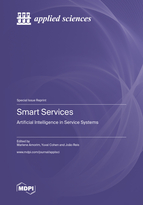Smart Services: Artificial Intelligence in Service Systems
A special issue of Applied Sciences (ISSN 2076-3417). This special issue belongs to the section "Computing and Artificial Intelligence".
Deadline for manuscript submissions: closed (30 July 2022) | Viewed by 45100
Special Issue Editors
Interests: service operations; service quality; innovation; digitalization
Special Issues, Collections and Topics in MDPI journals
Interests: smart intelligent systems; service science; Industry 4.0; human–machine interaction; artificial emotional intelligence; operations management
Special Issues, Collections and Topics in MDPI journals
Interests: artificial intelligence; digitalization; industrial engineering; operations management; service operations
Special Issues, Collections and Topics in MDPI journals
Special Issue Information
Dear Colleagues,
Service provision systems have been pioneers in the experimentation of human–computer interactions with frontline employees, and with customers. This led to the development of systems for the effective integration of providers’ resources, employees, technology, and the customers. A prominent example has been the early adoption of online and mobile service delivery channels. This adoption triggered innovation in the design of service experiences, and in extending access and service convenience at an unprecedented pace. Digital technologies therefore find a fertile ground in services, where information is a core input for service production systems that can be exchanged and modified by different users and service contexts. The recent developments and the adoption of advanced information technologies (e.g., Internet-of-Things (IoT), cyber-physical systems, cloud computing) and artificial intelligence (e.g., machine learning (ML), computer vision (CV), sound and speech recognition, natural language processing (NLP)) are triggering promising new avenues for service innovation and the emergence of smart service systems. The expanding links between the physical world and networked technologies, including networked sensors, creates a powerful and augmented space for the interactions and collaboration between service providers and customers for value creation.
In today’s competitive business environment, organizations are facing challenges in dealing with big-data issues and real-time decision-making for improved customer satisfaction. Another challenge is to exploit the confluence of several new promising technologies, such as emotion recognition by tone and facial analysis, natural language processing (NLP), speech recognition, gesture recognition, etc. This confluence was the motivation for Germany to lead a transformation toward the 4th Generation Industrial Revolution (Industry 4.0) based on cyber-physical-system-enabled manufacturing and service innovation. As more software and embedded intelligence are integrated in various services, advanced technologies can further interlace intelligent algorithms with computing capabilities. These technologies will then be used to for the benefit of managing the customer journey as well as customer satisfaction.
Artificial intelligence (AI) is increasingly adopted in service production systems, and is a major source of innovation. Many aspects of modern service consumption are being progressively automated, opening opportunities for experimentation with big data and AI applications across a variety of sectors, including personal and financial services, health care, communications, education, transportation, travel and accommodation, to cite only a few. The adoption of such technologies is blurring the frontiers between the physical, digital, and biological spheres, and creating calls for the development of research and knowledge that can support decision-making in the management of such hybrid service systems, where the roles and responsibilities of humans is being redefined.
The Special Issue on “Artificial Intelligence Trends and Applications in Service Systems” welcomes submissions of recent research work on this promising application area for artificial intelligence. The call is open to a broad thematic range of papers covering the recent applications of big data and AI across service businesses, covering managerial and customer challenges, technologies, service robotics, and research trends aiming at offering to readers knowledge for extending the adoption of AI in services, and inspiring managerial decision and innovation in the field.
Recommended topics include, but are not limited to, the following:
- Harnessing artificial intelligence (AI) for smart service applications:
- Natural language processing (NLP);
- Machine learning (ML);
- Case-based reasoning (CBR);
- Human tracking technologies (e.g., gesture recognition, facial analysis, eye tracking, etc.);
- Industrial experiments and case studies dealing with smart services and platforms;
- Smart health services;
- A review of a smart service technology;
- Organizational transformation to smart service;
- Cyber infrastructure, IoT, and big data for smart service;
- Designing the smart service operations;
- Smart service ontology;
- Social aspects of smart service;
- Service improvement wait reduction in smart service system;
- Smart service tourism management;
- Sustainable and green service provision;
- Customer’s journey in the smart service environment;
- Dynamic real-time capabilities in a smart service system;
- Sustainable smart service operations;
- Service robots pilot applications and experiences.
Dr. Marlene Amorim
Dr. Yuval Cohen
Dr. João Reis
Guest Editors
Manuscript Submission Information
Manuscripts should be submitted online at www.mdpi.com by registering and logging in to this website. Once you are registered, click here to go to the submission form. Manuscripts can be submitted until the deadline. All submissions that pass pre-check are peer-reviewed. Accepted papers will be published continuously in the journal (as soon as accepted) and will be listed together on the special issue website. Research articles, review articles as well as short communications are invited. For planned papers, a title and short abstract (about 100 words) can be sent to the Editorial Office for announcement on this website.
Submitted manuscripts should not have been published previously, nor be under consideration for publication elsewhere (except conference proceedings papers). All manuscripts are thoroughly refereed through a single-blind peer-review process. A guide for authors and other relevant information for submission of manuscripts is available on the Instructions for Authors page. Applied Sciences is an international peer-reviewed open access semimonthly journal published by MDPI.
Please visit the Instructions for Authors page before submitting a manuscript. The Article Processing Charge (APC) for publication in this open access journal is 2400 CHF (Swiss Francs). Submitted papers should be well formatted and use good English. Authors may use MDPI's English editing service prior to publication or during author revisions.
Keywords
- service systems
- smart service
- service digitization
- customer interactions
- artificial intelligence
- emotion detection
- servitization
- service robots
- digitalization








